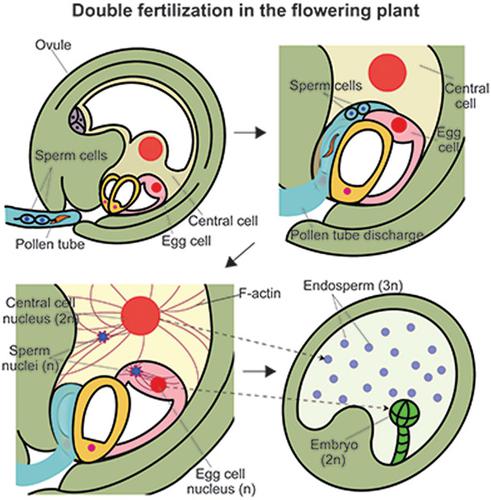当前位置:
X-MOL 学术
›
J. Exp. Zool. B Mol. Dev. Evol.
›
论文详情
Our official English website, www.x-mol.net, welcomes your
feedback! (Note: you will need to create a separate account there.)
Cellular dynamics of double fertilization and early embryogenesis in flowering plants
Journal of Experimental Zoology-B: Molecular and Developmental Evolution ( IF 1.8 ) Pub Date : 2020-07-08 , DOI: 10.1002/jez.b.22981 Ji Min Shin 1, 2, 3 , Ling Yuan 1, 2 , Masaru Ohme-Takagi 3, 4 , Tomokazu Kawashima 1
Journal of Experimental Zoology-B: Molecular and Developmental Evolution ( IF 1.8 ) Pub Date : 2020-07-08 , DOI: 10.1002/jez.b.22981 Ji Min Shin 1, 2, 3 , Ling Yuan 1, 2 , Masaru Ohme-Takagi 3, 4 , Tomokazu Kawashima 1
Affiliation

|
Flowering plants (angiosperms) perform a unique double fertilization in which two sperm cells fuse with two female gamete cells in the embryo sac to develop a seed. Furthermore, during land plant evolution, the mode of sexual reproduction has been modified dramatically from motile sperm in the early-diverging land plants, such as mosses and ferns as well as some gymnosperms (Ginkgo and cycads) to nonmotile sperm that are delivered to female gametes by the pollen tube in flowering plants. Recent studies have revealed the cellular dynamics and molecular mechanisms for the complex series of double fertilization processes and elucidated differences and similarities between animals and plants. Here, together with a brief comparison with animals, we review the current understanding of flowering plant zygote dynamics, covering from gamete nuclear migration, karyogamy, and polyspermy block, to zygotic genome activation as well as asymmetrical division of the zygote. Further analyses of the detailed molecular and cellular mechanisms of flowering plant fertilization should shed light on the evolution of the unique sexual reproduction of flowering plants.
中文翻译:

开花植物双受精和早期胚胎发生的细胞动力学
开花植物(被子植物)进行独特的双重受精,其中两个精子细胞与胚囊中的两个雌配子细胞融合形成种子。此外,在陆地植物进化过程中,早期分化的陆地植物,如苔藓和蕨类植物以及一些裸子植物(银杏)的有性生殖方式已发生显着改变。和苏铁)转化为非运动精子,这些精子通过开花植物的花粉管传递给雌性配子。最近的研究揭示了复杂的双重受精过程的细胞动力学和分子机制,并阐明了动植物之间的差异和相似之处。在这里,通过与动物的简要比较,我们回顾了目前对开花植物受精卵动力学的理解,涵盖了从配子核迁移、核配和多精块到合子基因组激活以及受精卵的不对称分裂。对开花植物受精的详细分子和细胞机制的进一步分析应该有助于阐明开花植物独特的有性生殖的进化。
更新日期:2020-07-08
中文翻译:

开花植物双受精和早期胚胎发生的细胞动力学
开花植物(被子植物)进行独特的双重受精,其中两个精子细胞与胚囊中的两个雌配子细胞融合形成种子。此外,在陆地植物进化过程中,早期分化的陆地植物,如苔藓和蕨类植物以及一些裸子植物(银杏)的有性生殖方式已发生显着改变。和苏铁)转化为非运动精子,这些精子通过开花植物的花粉管传递给雌性配子。最近的研究揭示了复杂的双重受精过程的细胞动力学和分子机制,并阐明了动植物之间的差异和相似之处。在这里,通过与动物的简要比较,我们回顾了目前对开花植物受精卵动力学的理解,涵盖了从配子核迁移、核配和多精块到合子基因组激活以及受精卵的不对称分裂。对开花植物受精的详细分子和细胞机制的进一步分析应该有助于阐明开花植物独特的有性生殖的进化。











































 京公网安备 11010802027423号
京公网安备 11010802027423号